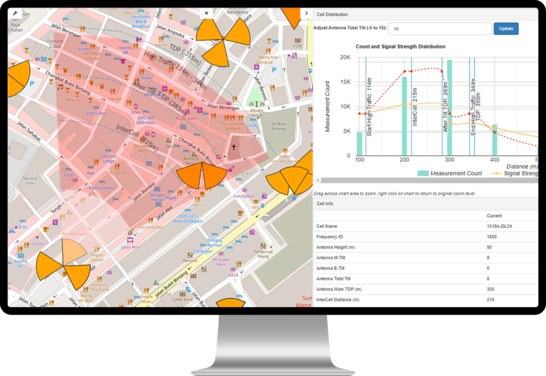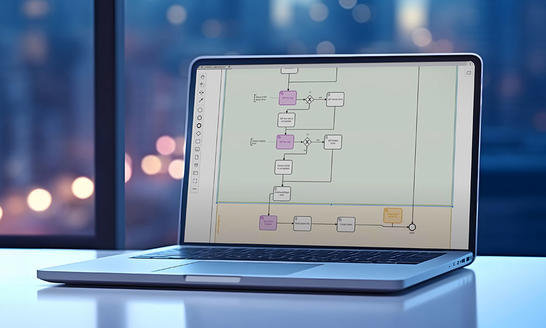Let’s deep dive into what is Service Assurance, which are its main benefits and challenges and how the assurance future looks for telecom operators with the advent of 5G and advanced technologies. We’ll also dig into what role AI, ML and automation play in transforming Service Assurance processes, which is the ultimate solution that combines these technologies to overcome the main challenges, as well as explore key use cases and success stories that have put these advancements in place to optimize their operations and customer experience.
What is Service Assurance in telecom?
Service Assurance in telecom involves the continuous monitoring, management, and optimization of networks to ensure predefined service level agreements (SLAs) and provide an optimal experience to end-users, focusing on maintaining peak performance, availability, reliability and addressing issues promptly.
In the context of 5G-era networks, service assurance becomes even more critical. The complexity of these networks, with their diverse services and intricate architecture, needs seamless interoperability between network and service assurance processes. This integration ensures a hierarchical alignment of the network layer, service layer, and customer layer. Such alignment is needed for setting operational prioritizations, allowing for efficient monitoring, troubleshooting, and resolution of issues, ultimately enhancing the overall quality of service.

The future of Service Assurance for telco operators
The future of service assurance involves adapting to the dynamic and complex nature of 5G networks, ensuring the delivery of enhanced mobile broadband, ultra-reliable low latency, and massive machine-type communications.
The focus shifts towards providing complete visibility and control, supporting new services, and meeting stringent SLAs to enhance customer experiences. In the realm of this new landscape, there are 5 key drivers for telco operators to ensure an effective service assurance:
According to a TM Forum’s research about Service Assurance in the 5G era, the main challenge for service assurance system providers is to proactively identify network issues impacting customer experience (CX).
Traditionally, directly linking network improvements to customer experience outcomes has been challenging due to the complexity of networks and OSS.
New service assurance systems such as Infovista Ativa™ are bridging this gap by connecting network and service operations to measure the impact of network issues on CX comprehensively.

As 5G and advanced networks are bringing more complexity to network operations, the siloed approach of legacy tools is resulting in poor customer experience, high OPEX and delayed response time. This necessitates a paradigm shift in the way networks are operated - CSPs need to embrace higher levels of automation to drive efficiency, cost savings, and an exceptional customer experience.

In the domain of modern analytics-driven OSS/BSS, a key principle for CSPs is to efficiently navigate vast data volumes to extract pertinent information related to specific service quality metrics. Positioned in the stack, service assurance serves as an intermediary layer, gathering network data and translating KPIs into a service-centric language. This facilitates the triggering of automated workflows to optimize operations with service awareness.
For that endeavour, Automated Assurance tools are rising as the solution for operators to transform network data into intelligence to drive decision-making and intent-driven automation, enabling them to:
- Cross-correlate service quality
- Orchestrate based on accurate data

In the rapidly evolving digital landscape of telecommunications, maintaining pace with technological advancements while meeting customer demands and ensuring seamless network performance is a persistent challenge for Communication Service Providers (CSPs). Openness, particularly through standardized architectures and Open APIs, emerges as a pivotal strategy for overcoming these challenges.
By aligning with the TM Forum’s Open Digital Architecture (ODA) and Open API initiatives, at Infovista we underscore our commitment to fostering collaboration and interoperability within the industry.
The telecom sector is increasingly eager to reap the benefits of the billions it has invested in 5G network deployments. However, many telcos are struggling to see the promised revenue.
According to Rick Hamilton, CEO at Infovista, the main application of 5G sits on the enterprise space more than on the consumer space. In this line of thought, 5G networks and fixed wireless access have a significant role in this sector, with a high potential for early monetization.
Hence, industry experts' thoughts point out that telcos will be initially investing more efforts in 5G Service Assurance for B2B Services and enterprises.
What are the top Service Assurance challenges?
In the field of Service Assurance, challenges include:
- Ensuring 5G slice health: This requires end-to-end visibility of 5G slices health and SLAs. The challenges lie in seamlessly correlating insights from various domains like 5G transport, RAN, edge, and core to proactively detect anomalies, perform root-cause analysis, and understand the impact on customer experience and SLAs. This means assurance tools must provide holistic, real-time intelligence and support open API integrations with external systems to drive the required changes in the network.
- Delivering premium VoNR services: The challenge in transitioning from legacy voice services to next-gen technologies like VoNR is ensuring end-to-end visibility across RAN, core, and IMS. CSPs need to get real-time analytics and automated root-cause analysis to deliver high-quality voice services with reliability.
- Guaranteeing VoIP services and SLAs for enterprise customers: For providers of VoIP services and unified communications to B2B, it is quite difficult to assure service quality and customer satisfaction. This involves comprehensive monitoring of transport and core networks, coupled with assessing the quality of service and experience. The challenge extends to providing correlated end-to-end SLA visibility and automated troubleshooting capabilities. Multi-tenant, self-service B2B portals become crucial for enterprise customers, contributing to service differentiation and monetization.
- Automating root-cause analysis and impact analysis: The challenge lies into achieving end-to-end visibility by correlating user experience to the network infrastructure. This entails comprehensive horizontal and vertical correlation, spanning from RAN to core and from the customer to infrastructure. The goal is to enable operations teams to quickly trace the root cause of quality-of-experience issues, reduce mean time to repair (MTTR), and prevent customer-impacting problems. Additionally, the challenge involves identifying the severity and impact of infrastructure and resource issues on customers, allowing prioritization for overall service reliability and optimal customer experience.
- Turning data into actionable insights to trigger the right automations: The overarching challenge is the vast volume and variety of data generated by networks. Operators face the task of making sense of this data to trigger precise automations and establish correlations between different network domains. This involves connecting data points to ensure that problems identified in one domain can be linked to their root causes in another. The challenge is to analyze data comprehensively, avoiding incorrect changes in the network and ensuring that alterations align with the actual problem areas. The aim is to leverage good data analysis for effective network management and meaningful business intelligence.
Overcoming complexity with Ativa™ Suite
The complexity demands new end-to-end service assurance. Infovista's Ativa Suite cloud-native solution provides automated assurance for fixed, mobile, legacy, and cloudified networks.
- Break down traditional silos and get a holistic view of services
- Correlate experience, service quality, and resource performance
- Monetize advanced SLA-backed revenue streams and automate operations
What are the benefits of Service Assurance?
Service assurance brings numerous benefits to telecom operators.
- It allows for the proactive identification and resolution of issues, leading to improved customer satisfaction.
- Differentiated SLAs enable the monetization of advanced, quality-driven services.
- The end-to-end visibility provided by service assurance solutions enhances operational efficiency, reduces costs, and accelerates the introduction of new revenue streams.

What CSPs should look for in evaluating Service Assurance solutions
When evaluating Service Assurance solutions, Communication Service Providers (CSPs) should consider that the solution they select includes features such as:
- End-to-end visibility: Comprehensive end-to-end visibility is crucial for CSPs to monitor and manage their networks seamlessly. This involves tracking the entire service delivery chain from the network infrastructure to the end user. This visibility ensures that CSPs can identify issues across multiple domains, enabling them to provide a consistent and high-quality customer experience. It allows for a holistic understanding of network performance, helping in quick issue detection, analysis, and resolution.
- Real-time analytics: Real-time analytics is essential for CSPs to stay proactive in addressing network challenges. The ability to analyze data in real-time provides instant insights into network performance, customer experience, and service quality. This enables CSPs to identify and respond to issues as they occur, ensuring a faster mean time to repair (MTTR). Real-time analytics also supports data-driven decision-making, allowing CSPs to adapt swiftly to dynamic network conditions and evolving customer demands.
- Automation capabilities: Automation plays a pivotal role in enhancing operational efficiency for CSPs. Automated processes can quickly detect, analyze, and, in some cases, resolve network issues without manual intervention. This not only reduces the workload on operational teams but also minimizes the potential for human errors. Automation is particularly crucial in the context of the evolving complexity of 5G networks, allowing CSPs to meet the demands for rapid service deployment, scalability, and reliability.
- Openness: An open architecture is vital for ensuring interoperability and flexibility in a rapidly evolving technology landscape. CSPs should prioritize solutions that embrace openness through standardized Application Programming Interfaces (APIs), as open systems facilitate seamless integration with other tools and platforms, fostering collaboration and interoperability. This enables CSPs to adapt to changing industry standards, incorporate new technologies, and future-proof their investments. Openness is a key factor in building a scalable and agile network infrastructure that can readily accommodate innovations and advancements in the telecommunications sector.
Next-generation automated assurance for 360° visibility
Get a unified view and actionable intelligence across digital experiences, apps, services, networks, and infrastructure. Explore Infovista's 360º Assurance solutions for real-time automated assurance of your services in one place.

The role for automation, AI, and Machine Learning in Service Assurance
Automation, Artificial Intelligence (AI), and Machine Learning (ML) play pivotal roles in enhancing service assurance. Automated workflows for anomaly detection, root-cause analysis, and customer-impact analysis streamline operations. AI and ML-driven predictive analytics enable proactive issue resolution and performance optimization. These technologies empower operators to respond swiftly to network anomalies, ensuring a seamless and reliable user experience.
Translating this into reality, Infovista’s Ativa Experience uses AI/ML capabilities to enable CSPs and enterprises to monitor and predict perceived customer experience KPIs and prevent and resolve issues.

How AIOps improves Service Assurance
AIOps, (Artificial Intelligence for IT Operations), leverages advanced algorithms and machine learning to enhance service assurance. By analyzing vast amounts of data in real-time, AIOps identifies patterns, predicts potential issues, and automates responses.
In the context of service assurance, AIOps:
- Improves efficiency
- Reduces Mean Time To Repair (MTTR)
- Enables operators to shift from reactive to proactive network management
Next-gen Service Assurance to monetize 5G and B2B services
Are you navigating the B2B landscape?
Delve into the key strategies for fast service deployment, SLA control at scale and exceptional customer experience for cutting-edge services and technologies such as IoT, 5G slicing and private networks.

Service Assurance use cases and success stories
Numerous use cases and success stories highlight the effectiveness of service assurance solutions. Infovista's Ativa Suite addresses critical use cases that contribute to revenue generation, improved customer experience, and operational excellence.
Use cases
- 5G Slicing and Fraud Prevention use cases
- Automated end to end troubleshooting – BT's success story
- IoT smart meters – Italgas' success story
- Customer experience enhancement – Cablenet's Success Story
- Traffic analytics democratization – BICS success story
5G Slicing and Fraud Prevention use cases
Within the scope of Service Assurance, few use cases stand out with as much promise as 5G slicing. By delivering 5G slices, CSPs can tailor services for individual subscribers, which not only heightens customer satisfaction but amplifies their 5G ROI.
Yet, another compelling use case unfolds — Fraud Prevention, a domain that a Tier 1 European operator is already addressing with Infovista’s Ativa solution.
By scrutinizing subscriber behavior and harnessing detailed data insights, enterprises can understand the subscriber experience to proactively prevent any potential scams, especially in critical areas such as banking transactions.
5G Slicing and Fraud Prevention use cases
Within the scope of Service Assurance, few use cases stand out with as much promise as 5G slicing. By delivering 5G slices, CSPs can tailor services for individual subscribers, which not only heightens customer satisfaction but amplifies their 5G ROI.
Yet, another compelling use case unfolds — Fraud Prevention, a domain that a Tier 1 European operator is already addressing with Infovista’s Ativa solution.
By scrutinizing subscriber behavior and harnessing detailed data insights, enterprises can understand the subscriber experience to proactively prevent any potential scams, especially in critical areas such as banking transactions.
BT's success story
BT UK aims to expedite response times by swiftly identifying the root-cause of customer or service disruptions, thus reducing Mean Time to Resolution (MTTR).
How are they doing this?
By using Infovista’s Ativa for fixed voice, BT has set up an automated workflow for issue detection, analysis, and alarm generation within BT's trouble-ticketing system. This has enabled them not only to streamline troubleshooting of network, service, and subscriber issues but also trimming operational costs.
The business outcome they are experiencing is a reduction of up to 80% of resolution times!
BT's success story
BT UK aims to expedite response times by swiftly identifying the root-cause of customer or service disruptions, thus reducing Mean Time to Resolution (MTTR).
How are they doing this?
By using Infovista’s Ativa for fixed voice, BT has set up an automated workflow for issue detection, analysis, and alarm generation within BT's trouble-ticketing system. This has enabled them not only to streamline troubleshooting of network, service, and subscriber issues but also trimming operational costs.
The business outcome they are experiencing is a reduction of up to 80% of resolution times!
Italgas' success story

Italgas, Italy's premier gas distributor, has recently achieved the milestone of monitoring 8 million connected smart meters nationwide.
The automated assurance of Italgas’ vast IoT network, backed by Infovista’s Ativa's cloud-native and open platform, ensures quick issue identification, allowing prompt root-cause resolution.
The business outcomes that the company expects to achieve more than 90% cost reduction through operational efficiencies.
Italgas' success story

Italgas, Italy's premier gas distributor, has recently achieved the milestone of monitoring 8 million connected smart meters nationwide.
The automated assurance of Italgas’ vast IoT network, backed by Infovista’s Ativa's cloud-native and open platform, ensures quick issue identification, allowing prompt root-cause resolution.
The business outcomes that the company expects to achieve more than 90% cost reduction through operational efficiencies.
Cablenet's Success Story

Cablenet, the fastest-growing telco provider in Cyprus, is automating their assurance processes for its fixed and mobile networks.
Cablenet’s uses Infovista’s Ativa Experience to provide their customer care and NOC/SOC teams with powerful and actionable insights into their subscribers’ end-to-end experience. This enables these teams to proactively monitor, identify, prioritize and resolve any customer-impacting issue.
Cablenet's Success Story

Cablenet, the fastest-growing telco provider in Cyprus, is automating their assurance processes for its fixed and mobile networks.
Cablenet’s uses Infovista’s Ativa Experience to provide their customer care and NOC/SOC teams with powerful and actionable insights into their subscribers’ end-to-end experience. This enables these teams to proactively monitor, identify, prioritize and resolve any customer-impacting issue.
BICS success story

As a leading international communications enabler, BICS offers a comprehensive suite of advanced analytics solutions for its telco and enterprise customers.
BICS uses detailed, near real-time traffic insights from Infovista’s Automated Assurance & Operations solution to enable both traditional telcos and enterprise customers alike to monitor, control and optimize the quality of their global communications services.
At the same time, BICS has been able to break down silos, experiencing greater scalability, improved efficiency, reduction in tech complexity and better customer experience.
Learn more on how telcos can benefit from unified assurance processes to deliver better experiences by listening to the podcast interview with BICS and Infovista.
BICS success story

As a leading international communications enabler, BICS offers a comprehensive suite of advanced analytics solutions for its telco and enterprise customers.
BICS uses detailed, near real-time traffic insights from Infovista’s Automated Assurance & Operations solution to enable both traditional telcos and enterprise customers alike to monitor, control and optimize the quality of their global communications services.
At the same time, BICS has been able to break down silos, experiencing greater scalability, improved efficiency, reduction in tech complexity and better customer experience.
Learn more on how telcos can benefit from unified assurance processes to deliver better experiences by listening to the podcast interview with BICS and Infovista.
Get in touch
Building relationships is what we do best, we are excited to connect




